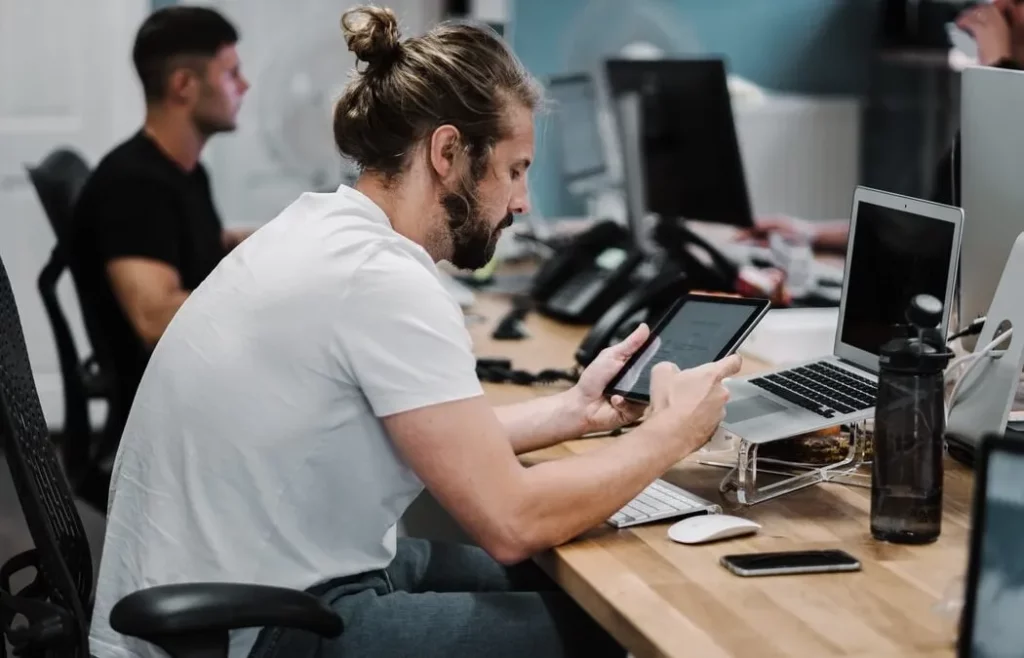5 Easy Exercises to do at Your Desk to Ease Aches and Pains

General aches and pains have become increasingly more common over the past 18 months due to a reduction of activity during the various lockdowns, and many people having to work from home in less than ideal, non-ergonomic environments.
As many commutes have been reduced to just a few steps from the bedroom to the home office, people are registering just a few thousand steps per day which, for aches and pains, is a recipe for disaster.
This blog will outline some easy exercises to do at your desk alongside some simple advice to reduce the risk of enduring postural aches and pains as a result of decreased activity.
5 easy exercises to do at your desk
As we all know, the human body is designed for movement, rather than constant sitting and inactivity. In sedentary office jobs, where many people regularly work overtime, the constant lack of movement and poor posture can wreak havoc on our hips, lower back, neck and shoulders.
For Physiotherapists, it’s no surprise that around 90% of people who seek help for postural aches and pains are sedentary office workers
So, whether you’re still working from home, or have moved back into the office environment, integrating these simple exercises you can do at your desk into your daily work routine can help you reduce muscle tightness, joint stiffness, and the aches and pains that come alongside them.
Perform each desk exercise for 60 – 90 seconds, ideally 2-3 times throughout the working day.
Sitting toe touches
Sitting on your desk chair, start with your hands on both thighs and slowly bend down, trailing your hands down the inside of your legs reaching the floor (or as far down as you are able).
Hold for 5 seconds at the bottom and then slowly curl yourself back up. This is a great mobility exercise to do at work that stretches the lower back, spine, and hip joint.
Sitting chair rotations
Sat upright on your chair, have your hands interlocked resting on your neck. From here, keeping a long straight spine, rotate from your spine, trying to reach 45 degrees to either side.
Complete slow repetitions with a few seconds hold on each side. This sitting desk exercise is perfect for thoracic spine stiffness, which is the area of the spine in the mid part of the back.
Sitting side stretch
Sitting on your desk chair, interlock your fingers and place them on the back of your neck. Sit up nice and tall, drop one elbow down to the floor whilst the other raises up to the ceiling, bending at the waist. On the raised elbow side, you will feel a nice stretch down the side of the torso.
Push into this stretch by trying to elongate that side of the torso. Hold the stretch for 20 seconds and repeat on the other side. This is a great stretch to offset any muscle tightness in the sides of the torso.
Seated spine extension
Sitting on your desk chair, place your hands interlocked behind your head with your arms next to your ears. Lean back and extend your torso over the back of the chair, completing slow repetitions bending back and forth.
As we spend most of the time sitting hunched at our desks, this is a great exercise to do at your desk that will help to mobilise the spine into extension.
Sitting pelvic tilts
On your desk chair, sit up tall. From here, start to tilt the pelvis back and forth. You will feel yourself slouch and then sit up straight as you tilt between the two movements.
This is a great mobility desk exercise to mobilise the hips and lower back to reduce joint stiffness.
Other simple exercises if you have more time & space
When it comes to postural aches and pains the absolute #1 treatment is to sit less and move more. Our postural position is much less important than you may think, it’s all to do with the amount of time you are in a posture for, rather than the posture you are in.
The best posture is your next one, as we need to change positions more often.
Aside from posture, there are small exercises we can do throughout the working day to promote increased movement.
- Take a lunchtime walk, even just for 20 minutes. This will make a huge difference! The more steps we can get in during the day the better. Set targets to be met by certain times of the day, e.g. 4000 steps by midday.
- If you are able, take the stairs more often.
- On certain days, where you may have a longer lunch break, or have work-from-home flexibility, make the most of it! There are thousands of lunchtime pilates or yoga classes on YouTube ranging from 10 – 30 minutes in duration. These are brilliant to reduce muscle tightness and joint stiffness, helping to reduce the prevalence of postural aches and pains.
- Use a spiky ball or tennis ball for some deep tissue release work. Working a tennis ball deep into the glutes or lower back whilst standing against a wall is a great way to reduce muscle tightness. This also applies for the neck and shoulders.
Sports Massage at Katie Bell Physio
Sports Massage is an extremely popular treatment at Katie Bell Physiotherapy & Wellness due to the amazing benefits it provides to desk-based workers who are suffering from postural aches and pains.
Sports Massage works by deeply working into muscle tissue to increase blood flow, remove waste products and reduce muscle tightness, leaving you less tense and more relaxed! Many of our clients see us routinely, every 4-6 weeks, to keep on top of their postural aches and pains as a form of body MOT.
Learn more about our Sports Massage service here, or get in touch to book an appointment today.

